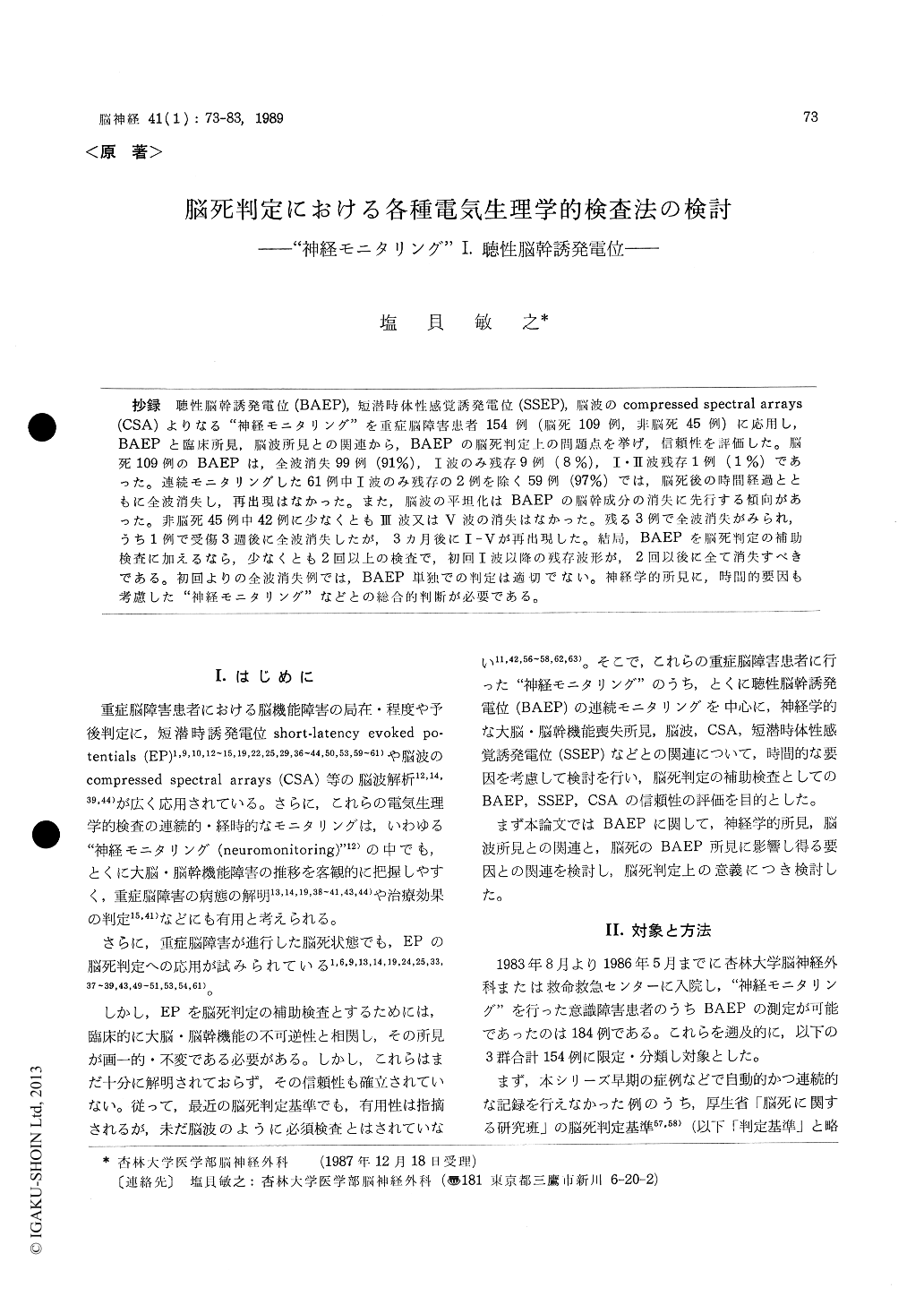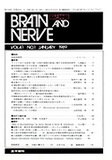Japanese
English
- 有料閲覧
- Abstract 文献概要
- 1ページ目 Look Inside
抄録 聴性脳幹誘発電位(BAEP),短潜時体性感覚誘発電位(SSEP),脳波のcompressed spectral arrays(CSA)よりなる"神経モニタリング"を重症脳障害患者154例(脳死109例,非脳死45例)に応用し,BAEPと臨床所見,脳波所見との関連から,BAEPの脳死判定上の問題点を挙げ,信頼性を評価した。脳死109例のBAEPは,全波消失99例(91%),I波のみ残存9例(8%),I・II波残存1例(1%)であった。連続モニタリングした61例中1波のみ残存の2例を除く59例(97%)では,脳死後の時間経過とともに全波消失し,再出現はなかった。また,脳波の平坦化はBAEPの脳幹成分の消失に先行する傾向があった。非脳死45例中42例に少なくともIII波又はV波の消失はなかった。残る3例で全波消失がみられ,うち1例で受傷3週後に全波消失したが,3カ月後にI-Vが再出現した。結局,BAEPを脳死判定の補助検査に加えるなら,少なくとも2回以上の検査で,初回1波以降の残存波形が,2回以後に全て消失すべきである。初回よりの全波消失例では,BAEP単独での判定は適切でない。神経学的所見に,時間的要因も考慮した"神経モニタリング"などとの総合的判断が必要である。
Electrophysiological neuromonitoring12) of brain-stem auditory evoked potentials (BAEP), short-latency somatosensory evoked potentials (SSEP) and compressed spectral array (CSA) EEG can pro-vide precise and immediate information concerning functional integrity of the brain, brainstem and upper spinal cord of severely brain-damaged pa-tients14,15,19,38~41,43,44). We applied this neuromoni-toring system in the cases of 154 severely brain-damaged patients in order to evaluate its reliabil-ity in the diagnosis of brain death. In particular,this study considers the relationships between BAEP and neurological findings, conventional EEG findings and factors affecting final BAEP findings. As a result, we evaluated the significance of BAEP in the diagnosis of brain death.
A total of 109 brain-dead patients were divided into two groups : group A with 48 patients deter-mined brain dead neurologically and by EEG prior to BAEP monitoring, and group B with 61 patients who had undergone automatic BAEP monitoring every 10 to 30 minutes before and/or after deter-mination of clinical brain death. A third group, C, included 45 non brain-dead patients subjected to neuromonitoring, and served as a comparative group.
Brain damage was caused by subarachnoid he-morrhage in 50 patients, intracerebral hemorrhage in 36, cerebral infarction in 8, head injury in 47, meningitis in 3, brain tumor in 3 and anoxia in 7. There were no significant differences in causes among the three groups (χ2)=20.3). The mean ages in the three groups were 50 (ages 10-91) in group A, 51 (14-86) in group B, and 50 (5-87) in group C. There were no significant differences in age distribution among the three group (χ2)=25.0). The last BAEP findings of the 109 brain-dead patients indicated loss of all waves in 99 (91%), the presence of wave I in 9 (8%), and the presence of waves I and II in one patient (1%) (Table 1).
Only three of the 45 group C non brain-dead patients indicated loss of all BAEP waves within one month after onset (Table 1). The one demon-strated loss of all BAEP waves 17 days after her accident, with recovery of waves I to V three months later44).
The temporal relationships in group B patients of the course of BAEP findings and the time of neurological brain death diagnosis are shown in Table 2 and Fig. 1. All but two of the 61 patients were followed up until final loss of BAEP waves (Fig. 1). At the time of fulfillment of neurological criteria of brain death, BAEP wave III was present in 3 of 48 patients who had not been given barbi-turate treatment (Table 2).
Relationship between the EEG and BAEP find-ings of group B patients demonstrated an electro-cerebral silence preceding the loss of all BAEP waves (Table 3). However, BAEP indicated the loss of all waves in two patients still showing bio-logical EEG activity and brainstem reflexes. In brain-dead groups A & B, there were no correla-tions between final BAEP findings and causes of brain death, age distribution, body temperature, and systolic blood pressure (Tables 4 to 7).
Reliable diagnosis of brain death is difficult if based on only one BAEP test because false-positiveand false-negative results always are a possibi-iity2,6,9,19,38,49,54,59).
If BAEP are to serve in the diagnosis of brain death, then at least two examinations should be carried out. It first is necessary to confirm the integrity of BAEP waves and then the loss of all waves. If a loss of all BAEP waves is observedinitially, then the confirmation of brain death should not be based only on the BAEP findings.
It therefore is suggested that neuromonitoring taking into consideration the temporal relation-ships between course and clinical findings is re-quired for ultimate diagnosis of brain death.

Copyright © 1989, Igaku-Shoin Ltd. All rights reserved.


